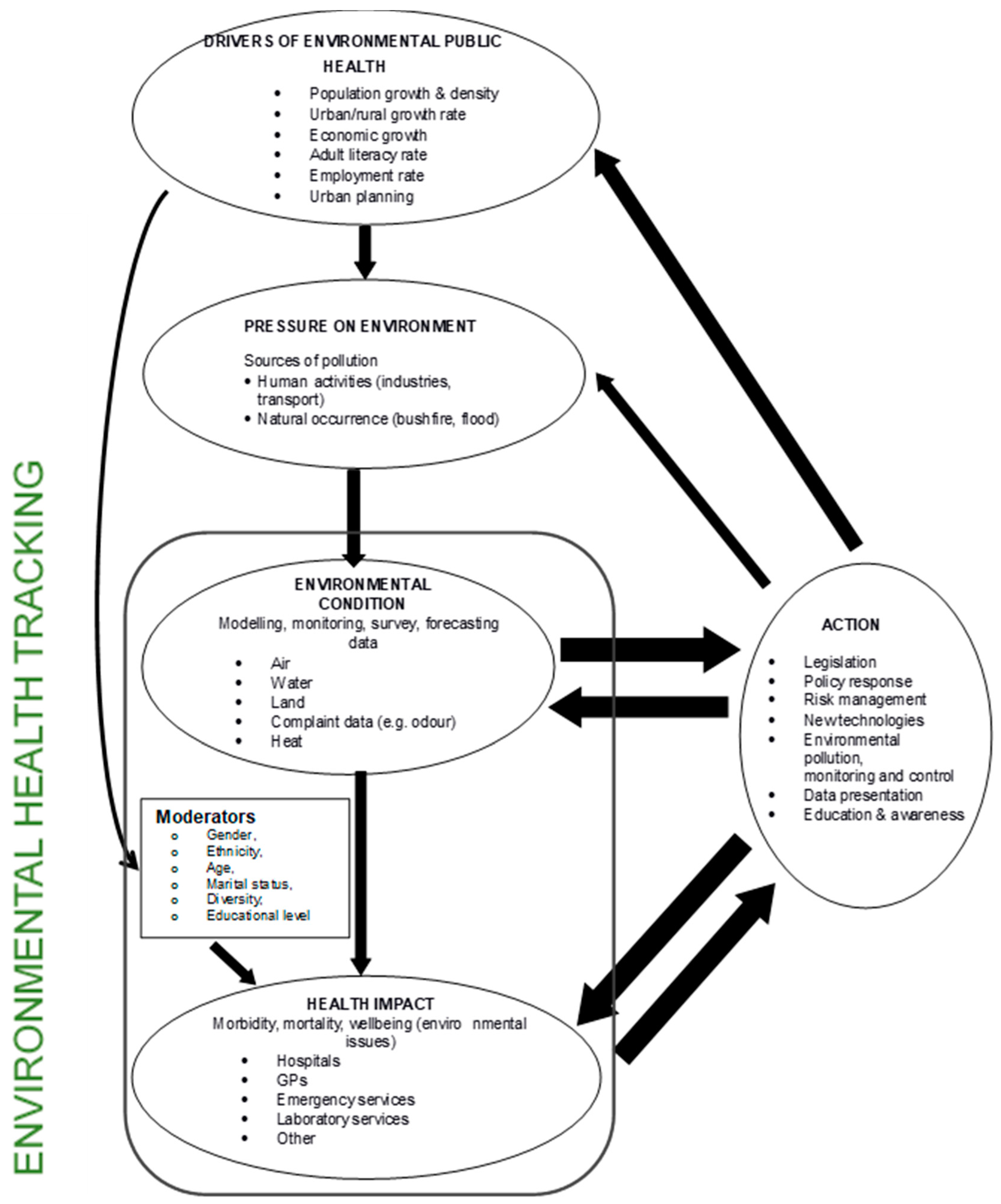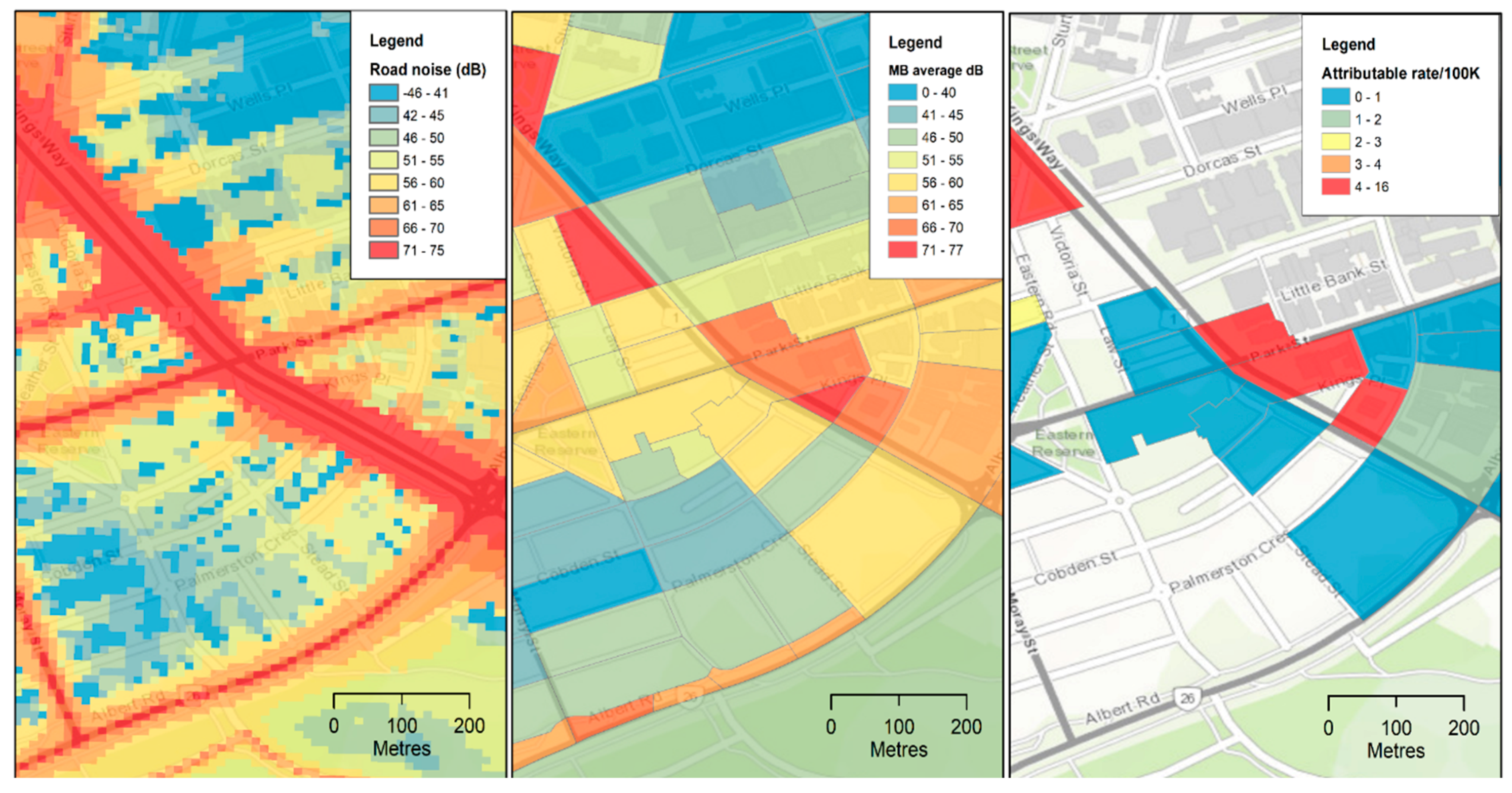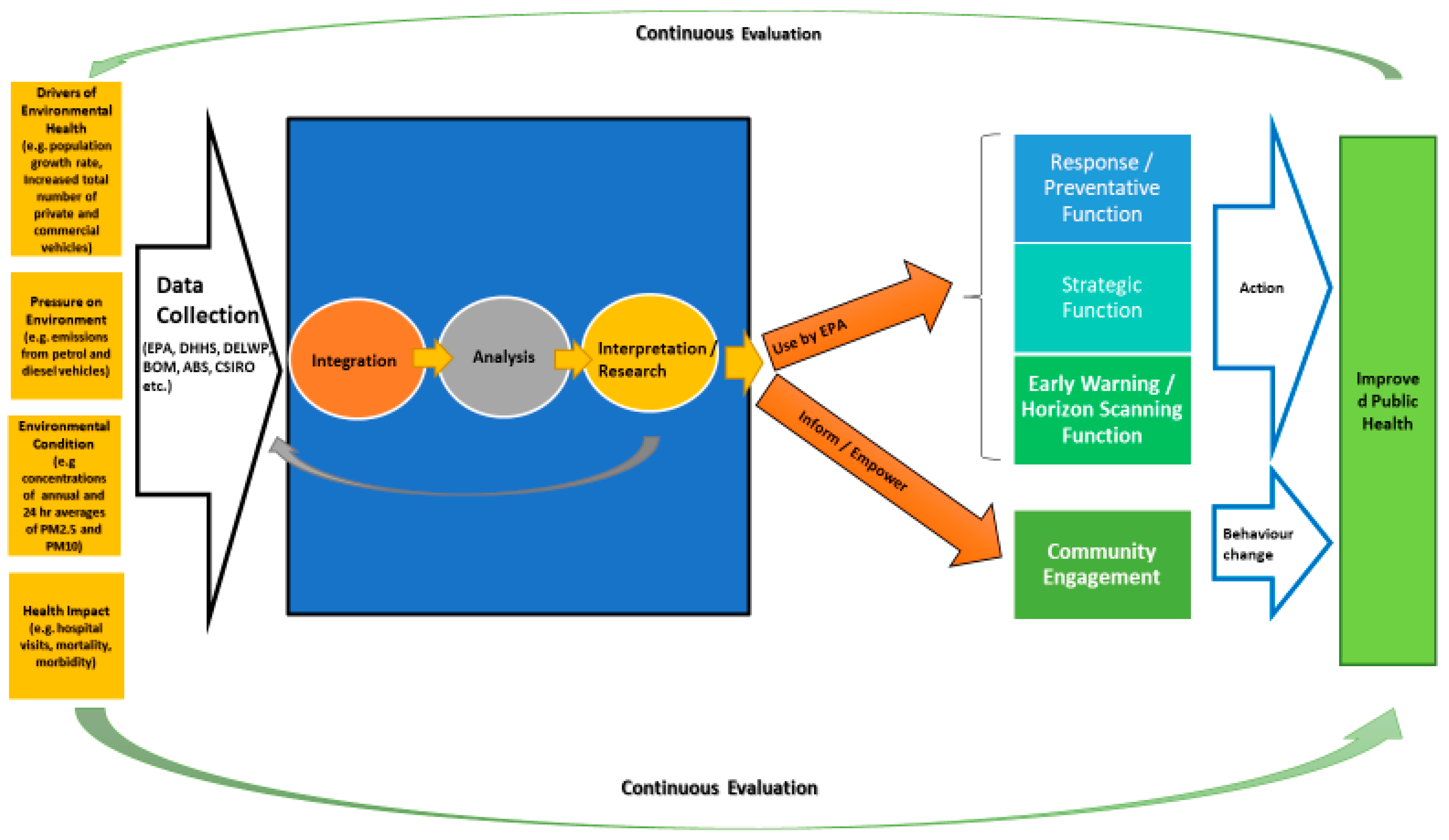Developing a Conceptual Framework for Environmental Health Tracking in Victoria, Australia
Abstract
1. Introduction
- (1)
- To proactively investigate the short- and long-term temporal and spatial trends of environmental conditions and adverse health effects to help guide interventions and prevent harm to human health resulting from environmental pollution or waste.
- (2)
- To have access to short- and long-term trends to respond to community concerns related to environmental public health issues.
- (3)
- To make relevant environmental public health tracking data available to stakeholders (e.g., public, government departments, and researchers) on a spatial and temporal scale in an easy to understand format.
- (4)
- To respond to emerging environmental health threats, clusters, and outbreaks by identifying populations at risk for adverse health effects.
- (5)
- To investigate relationships between environmental contamination and health effects for specific cases.
- (6)
- To develop routine tracking of adverse health effects on a small scale and identify areas warranting further investigation.
- (7)
- To increase partnerships and collaborations between traditional environmental and health entities at federal, state, and local government levels by developing networks.
- Investigating the feasibility of implementing EHTS in Victoria;
- Developing a conceptual framework for the EHTS;
- Developing and identifying environmental health indicators for the EHTS;
- Developing a technical implementation plan for the system architecture of the EHTS;
- Implementing the EHTS with available data; and
- Evaluation of the effectiveness of the EHTS;
2. Strategy for Developing Environment Protection Authority (EPA)’s Environmental Health Tracking Conceptual Framework
- formulating objectives for EPA Victoria’s environmental health tracking and providing ideas for its conceptual framework design process;
- reviewing available data sources for the EHTS;
- identifying a suitable conceptual framework for EPA Victoria’s EHTS; and
- conducting a preliminary case study within the context of the conceptual framework.
3. Available Conceptual Frameworks for Environmental Health Tracking
4. Choosing a Conceptual Framework
5. Availability of Data
6. Proposed Conceptual Framework for EPA’s Environmental Health Tracking
7. EPA Victoria’s Drivers-Pressure-Environmental Condition-Health Impact-Action (DPEHA) Conceptual Framework
8. Potential Application of the Environmental Health Tracking System
- provide scientific evidence for EPA Victoria for improved public health and the environment in the state;
- provide information for Victorians in making informed decisions on things affecting their health; and
- respond in a timely and effective way to community concerns on environmental health-related issues.
9. Conclusions
Author Contributions
Funding
Acknowledgments
Conflicts of Interest
References
- World Health Organisation (WHO). Regional Office for Europe, European Centre for Environment and Health. Development of Environment and Health Indicators for the European Union Countries (ECOEHIS). Final Report. 2004. Available online: https://apps.who.int/iris/bitstream/handle/10665/107620/E85061.pdf?sequence=1 (accessed on 25 April 2019).
- Centres for Disease Control and Prevention. Guide to Building and Environmental Public Health Tracking Network. 2011. Available online: https://www.cdc.gov/nceh/tracking/pdfs/how_to_guide.pdf (accessed on 24 September 2018).
- Ministry of Health. Environmental Health Indicators for New Zealand 2008; Ministry of Health: Wellington, New Zealand, 2009. Available online: https://www.health.govt.nz/system/files/documents/publications/environmental-health-nz-08.pdf (accessed on 24 September 2018).
- Victoria State Government of Australia. Melbourne (AUST): Ministerial Advisory Committee, Victoria Government; Independent Inquiry into the Environment Protection Authority Victoria. 31 March 2016. Available online: http://epainquiry.vic.gov.au/__data/assets/file/0008/336698/Inquiry-report-EPA_June.pdf (accessed on 4 June 2018).
- Thacker, S.B.; Troup, D.F.; Parrish, R.G.; Anderson, H.A. Surveillance in environmental public health: Issues, systems, and sources. Am. J. Public Health 1996, 86, 633–641. [Google Scholar] [CrossRef] [PubMed]
- Waheed, B.; Khan, F.; Veitch, B. Linkage-Based Frameworks for Sustainability Assessment: Making a Case for Driving Force-Pressure-State-Exposure-Effect-Action (DPSEEA) Frameworks. Sustainability 2009, 1, 441–463. [Google Scholar] [CrossRef]
- Hambling, T.; Weinstein, P.; Slaney, D.A. Review of Frameworks for Developing Environmental Health Indicators for Climate Change and Health. Int. J. Environ. Res. Public Health 2011, 8, 2854–2875. [Google Scholar] [CrossRef] [PubMed]
- Dumanski, J.; Pieri, C. Application of the pressure-state-response framework for the land quality indicators (LQI) programme. In Land Quality Indicators and Their Use in Sustainable Agriculture and Rural Development, Proceedings of the Workshop, Rome, Italy, 25–26 January 1996; Land and Water Development Division, FAO Agriculture Department and the Research, Extension and Training Division, FAO Sustainable Development Department: Rome, Italy, 1997. [Google Scholar]
- von Schirnding, Y.E. Health-and-environment indicators in the context of sustainable development. Can. J. Public Health 2002, 93, 9–15. [Google Scholar]
- World Health Organisation. Framework for Linkages between Health, Environment and Development. Available online: http://www.who.int/mediacentre/events/IndicatorsChapter7.pdf (accessed on 14 October 2018).
- Liu, H.Y.; Bartonova, A.; Pascal, M.; Smolders, R.; Skjetne, E.; Dusinska, M. Approaches to integrated monitoring for environment and health impact assessment. Environ. Health 2012, 11, 88. [Google Scholar] [CrossRef] [PubMed]
- Lam, S.; Leffley, A.; Cole, D.C. Applying an Ecohealth perspective in a state of the environment report: Experiences of a local public health unit in Canada. Int. J. Environ. Res. Public Health 2014, 12, 16–31. [Google Scholar] [CrossRef] [PubMed]
- Corvalán, C.; Nurminen, M.; Pastides, H.; World Health Organization; Office of Global and Integrated Environmental Health. Linkage Methods for Environment and Health Analysis: Technical Guidelines: A Report of the Health and Environment Analysis for Decision-Making; World Health Organization: Geneva, Switzerland, 1997; Available online: http://www.who.int/iris/handle/10665/63490 (accessed on 11 November 2018).
- European Environment Agency. EEA Core Set of Indicators–Guide. EEA Technical Report 2005. Available online: File: https://www.eea.europa.eu/publications/technical_report_2005_1 (accessed on 11 August 2018).
- Organisation for Economic Co-operation and Development. OECD core set of indicators for environmental performance reviews: A synthesis report by the Group on the State of the Environment. Environ. Monogr. 1993, 83, 1–39. [Google Scholar]
- McGeehin, M.A.; Qualters, J.R.; Niskar, A.S. National Environmental Public Health Tracking Program: Bridging the Information Gap. Environ. Health Perspect. 2004, 112, 1409–1413. [Google Scholar] [CrossRef] [PubMed]
- Gentry, S.J.; Bartram, J. Human health and the water environment: Using the DPSEEA framework to identify the driving forces of disease. Sci. Total Environ. 2013, 468–469, 306–314. [Google Scholar]
- Briggs, D.; Corvalan, C.; Nurminen, M. Linkage Methods for Environment and Health Analysis; UNEP/US EPA/WHO: Geneva, Switzerland, 1996. [Google Scholar]
- Sandifer, P.A.; Knapp, L.C.; Collier, T.K.; Jones, A.L.; Juster, R.P.; Kelble, C.R.; Sutton-Grier, A.E. A conceptual model to assess stress-associated health effects of multiple ecosystem services degraded by disaster events in the Gulf of Mexico and elsewhere. GeoHealth 2017, 1, 17–36. [Google Scholar] [CrossRef] [PubMed]
- Hinze, B. Estimation of Environmental Noise Exposure–Greater Melbourne; WSP Acoustics, Parsons Brinckerhoff: Melbourne, Victoria, Australia, 2013. [Google Scholar]
- Australian Institute of Health and Welfare (AIHW). Mortality Over Regions and Time (MORT) Books Local Government Area (LGA), 2011–2015 Table 2: Leading Causes of Death by Sex, 2011–2015; Australian Institute of Health and Welfare (AIHW): Canberra, Australia, 2015.
- Australian Bureau of Statistics (ABS). Census Data. Available online: http://www.abs.gov.au/ (accessed on 30 November 2018).



| Conceptual Framework | Required Attributes for Environment Protection Authority (EPA)’s Conceptual Framework | |||||
|---|---|---|---|---|---|---|
| Driving Force | Pressure | State/Hazard Surveillance | Exposure/Exposure Surveillance | Effect/Impact/Health Surveillance | Action/Response | |
| Thacker et al. [5] | X | X | X | |||
| PSR * [15] | X | X | X | |||
| DPSIR ** [14] | X | X | X | X | ||
| DPSEEA *** [13] | X | X | X | X | X | X |
| Conceptua Framework | Criteria for Developing EPA’s Conceptual Framework | ||||||
|---|---|---|---|---|---|---|---|
| Use Existing Ongoing Monitoring Data | Integrate Existing Data and New Data | Be Used in Developing Environmental Health Indicators | Linkage of Environmental Exposure and Health Effects Back to Their Determining Factors | Link Environmental Health Tracking to Public Health Action | Identify Intervention Points along Environmental Health Causal Component | Measure Impacts of Actions Taken to Improve Health | |
| Thacker et al. [5] | X | X | X | X | |||
| PSR * [15] | X | X | |||||
| DPSIR ** [14] | X | X | X | X | X | ||
| DPSEEA *** [13] | X | X | X | X | X | X | X |
| DPEHA Conceptual Aspect | Data Inputs |
|---|---|
| Driving force | Population increase in Victoria |
| Increased demand for road networks | |
| Increased total number of private and commercial vehicles (cars, vans, trucks, and buses) | |
| Increase in ownership of petrol and diesel vehicles | |
| Pressure | Average age of vehicles (older vehicles may release more PM2.5 and PM10 than newer vehicles) |
| Busy roads | |
| Emissions from petrol and diesel vehicles | |
| Cars not maintained well could produce more emissions | |
| Environmental Conditions | Monitoring and modeled concentrations of ambient PM2.5 and PM10 from car emissions collected over time |
| Health Impact | Premature deaths and hospital admissions for respiratory and respiratory conditions |
| Estimated disability-adjusted life years lost attributable to PM2.5 exposure | |
| Action | Policies to improve air quality |
| Use of available technologies and controls to reduce emissions from road vehicles | |
| Public awareness campaign | |
| Community engagement through educational programs |
© 2019 by the authors. Licensee MDPI, Basel, Switzerland. This article is an open access article distributed under the terms and conditions of the Creative Commons Attribution (CC BY) license (http://creativecommons.org/licenses/by/4.0/).
Share and Cite
Edokpolo, B.; Allaz-Barnett, N.; Irwin, C.; Issa, J.; Curtis, P.; Green, B.; Hanigan, I.; Dennekamp, M. Developing a Conceptual Framework for Environmental Health Tracking in Victoria, Australia. Int. J. Environ. Res. Public Health 2019, 16, 1748. https://doi.org/10.3390/ijerph16101748
Edokpolo B, Allaz-Barnett N, Irwin C, Issa J, Curtis P, Green B, Hanigan I, Dennekamp M. Developing a Conceptual Framework for Environmental Health Tracking in Victoria, Australia. International Journal of Environmental Research and Public Health. 2019; 16(10):1748. https://doi.org/10.3390/ijerph16101748
Chicago/Turabian StyleEdokpolo, Benjamin, Nathalie Allaz-Barnett, Catherine Irwin, Jason Issa, Pete Curtis, Bronwyn Green, Ivan Hanigan, and Martine Dennekamp. 2019. "Developing a Conceptual Framework for Environmental Health Tracking in Victoria, Australia" International Journal of Environmental Research and Public Health 16, no. 10: 1748. https://doi.org/10.3390/ijerph16101748
APA StyleEdokpolo, B., Allaz-Barnett, N., Irwin, C., Issa, J., Curtis, P., Green, B., Hanigan, I., & Dennekamp, M. (2019). Developing a Conceptual Framework for Environmental Health Tracking in Victoria, Australia. International Journal of Environmental Research and Public Health, 16(10), 1748. https://doi.org/10.3390/ijerph16101748





